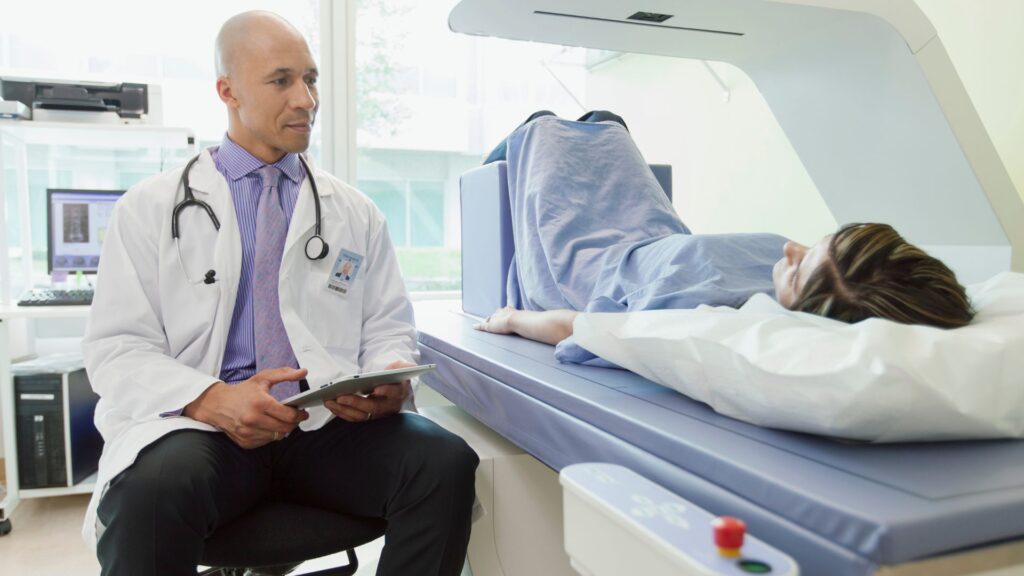Are you experiencing bone pain or muscle weakness and can’t figure out why? It could be a sign of osteomalacia, a condition that softens your bones. This isn’t something to ignore.
Osteomalacia can make your bones more prone to fractures and lead to serious health issues if left untreated.
Here’s a fact: the most common cause of osteomalacia is vitamin D deficiency. Our blog post will guide you through everything from symptoms to treatments – including supplements and medicines that can help.
We’ll offer clear steps on how to manage this condition effectively.
Stay tuned for insights that could make a world of difference.
Key Takeaways
- Osteomalacia means bones become soft because they don’t have enough vitamin D or calcium. This condition causes pain and makes bones break easily.
- To find out if you have osteomalacia, doctors do blood tests, bone density scans, and X-rays. These help see if your bones are soft.
- You can treat osteomalacia by taking vitamin D and calcium supplements. Sometimes people might need surgery if their condition is severe.
- Getting sunshine helps your body make its own vitamin D. Eating foods rich in vitamin D and exercising also keep bones strong.
- If you’re dealing with osteomalaciasupport from groups, learning about the condition, and talking to health experts can help manage symptoms better.
Understanding Osteomalacia

Osteomalacia is a condition where bones become soft due to a deficiency in vitamin D or calcium. This leads to weak bones that can easily fracture, affecting adults worldwide.
Definition and Overview
Osteomalacia involves the softening of bones due to improper bone mineralization. The main culprit behind this condition is a deficiency in Vitamin D, crucial for strong bones. This lack leads to symptoms such as bone pain and muscle weakness, which may progress to broken or deformed bones if left untreated.
A comprehensive approach is essential to tackle osteomalacia – from diagnosis through blood tests measuring vitamin D levels to adopting effective treatments aimed at restoring bone health and preventing further damage.
Understanding the causes and risk factors that lead to osteomalacia sets the foundation for recognizing early symptoms and seeking timely medical intervention.
Causes and Risk Factors
A lack of vitamin D tops the list as a major cause of osteomalacia. This crucial nutrient helps our bodies absorb calcium, which is essential for strong bones. Without enough vitamin D, calcium cannot work its magic, leading to softer bones and an increased risk of fractures.
Factors such as limited sun exposure, dietary deficiencies, and certain medical conditions like celiac disease can significantly reduce vitamin D levels in the body.
Other causes include specific nutritional deficiencies beyond just vitamin D. Insufficient intake of calcium directly impacts bone strength and density. Some medical treatments may interfere with the body’s ability to use these vital nutrients effectively, worsening the condition or hindering recovery from existing damage.
Recognizing symptoms early on plays a key role in addressing this preventable condition.
The goals of therapy for vitamin D-deficiency osteomalacia are to alleviate symptoms, promote fracture healing, and restore bone health.
Recognizing Symptoms of Osteomalacia
Spotting the signs of osteomalacia early can make a big difference. Look for key symptoms like deep bone pain or muscles feeling weak—these clues signal it’s time to seek help.
Bone Pain and Weakness
Bone pain and weakness are key symptoms of osteomalacia, a condition where bones become soft due to poor mineralization. This often stems from vitamin D deficiency, crucial for bone health.
People with this condition commonly experience deep, aching pains in their bones, especially in the lower back, hips, and legs. These pains worsen with movement and pressure. Muscle weakness also accompanies bone pain, making daily activities difficult.
The lack of strength disrupts routine tasks and can lead to more serious problems like frequent fractures. Bones weakened by osteomalacia break more easily than healthy bones, highlighting the importance of early diagnosis and proper treatment.
Recognizing these frequent fractures is another critical symptom of osteomalacia.
Frequent Bone Fractures
People with osteomalacia often have bones that break more easily than normal. A minor bump or fall can cause a fracture. This happens because their bones lack the minerals needed to be strong.
Many times, these fractures occur in the ribs, spine, and legs. These breaks can slow down daily activities and make life harder.
Muscles around weak bones might also feel sore or weak. This makes it hard to get up from a chair or climb stairs.
The goals of therapy for vitamin D-deficiency osteomalacia are to alleviate symptoms, promote fracture healing, and restore bone health.
Now let’s look into muscular weakness as another symptom of osteomalacia.
Muscular Weakness
Following frequent bone fractures, another critical symptom to consider in osteomalacia is muscular weakness. This condition doesn’t just soften bones but also significantly affects muscle strength.
Many suffer from difficulty getting up from a chair or climbing stairs—everyday tasks become challenging hurdles. This muscle weakness happens because the body lacks vitamin D, which is essential not just for bone health but also for muscle function.
Muscle pain might accompany this weakness, making movements stiff and painful. Since vitamin D deficiency lies at the core of osteomalacia, both bones and muscles struggle without enough of this crucial nutrient.
Addressing muscular weaknesses involves more than just managing symptoms; it requires tackling the underlying cause—boosting vitamin D levels to support muscle recovery alongside strengthening bones.
Diagnostic Approaches for Osteomalacia

Finding out if someone has osteomalacia involves specific tests. Doctors may use blood tests, bone density scans, and X-rays to look for signs of soft bones.
Blood Tests for Vitamin D and Calcium Levels
Doctors often use blood tests to check for vitamin D and calcium levels in people with symptoms of osteomalacia. These tests are crucial because they can show if there’s a deficiency causing the bones to soften.
Low levels of vitamin D lead to poor bone health, which is why these tests are a key step in diagnosing osteomalacia.
The goals of therapy for vitamin D-deficiency osteomalacia are to alleviate symptoms, promote fracture healing, and restore bone health.
Bone Density Scans
After checking vitamin D and calcium levels through blood tests, the next step involves bone density scans. These scans give a clear picture of bone health. They measure how dense or strong bones are, helping to spot softening bones—a key sign of osteomalacia.
Using a machine that sends low-level X-rays through the bones, this painless test tallies up the minerals in them and spots areas where mineralization might lack due to vitamin D deficiency.
This method is pivotal for diagnosing osteomalacia accurately. It pinpoints areas of concern long before fractures occur, allowing for early intervention with supplements or medications to strengthen weakened bones.
Bone density scans serve as a crucial tool in catching signs of soft bones early on, preventing further damage and aiding in effective treatment planning for restoring bone health.
X-rays and Bone Scans
Moving beyond bone density scans, X-rays and bone scans play a pivotal role in diagnosing osteomalacia. Doctors use X-rays to look for bone fractures and deformities that soft bones might cause.
These images help identify areas where bones are not mineralizing properly. The process is quick, providing vital information about the health of your skeletal system.
Bone scans take this examination further by injecting a small amount of radioactive material into the body. This material travels to places in the bones that are repairing themselves—an indicator of osteomalacia when found in adults without recent injuries.
Scans produce detailed images, showing doctors exactly where problems lie, guiding treatment plans effectively. Both methods are essential tools for spotting signs of weakened bones and ensuring patients receive accurate diagnoses and prompt care.
Effective Treatments for Osteomalacia
Effective treatments for Osteomalacia focus on boosting bone strength and health—explore how vitamins, medicines, and sometimes surgeries make a difference. Keep reading to uncover more solutions!
Vitamin D and Calcium Supplements
Osteomalacia softens bones due to poor mineralization, often linked to Vitamin D deficiency. Addressing this involves a regimented intake of Vitamin D and calcium supplements, pivotal for bone health restoration.
- Vitamin D Supplements – Key for absorbing calcium in the body. Doctors usually recommend high doses of vitamin D3 (cholecalciferol) to quickly boost levels and support bone healing.
- Calcium Supplements – These work alongside vitamin D to strengthen bones. The typical recommendation is 1000-1200 mg per day, divided into two doses for better absorption.
- Regular Monitoring – Blood tests check if supplement levels meet the body’s needs and ensure there’s no excess, which can harm the kidneys.
- Sunlight Exposure – Natural vitamin D creation gets triggered by sunlight on the skin. Just 10-15 minutes a day can significantly help, but it’s essential not to overdo it and risk skin damage.
- Dietary Adjustments – Incorporating foods rich in vitamin D and calcium, like fatty fish, dairy products, and fortified cereals, supports supplement efficacy.
- Adjustment Over Time – Dosages might change based on blood test results and symptom improvement, requiring ongoing dialogue with a healthcare provider.
- Awareness of Interactions – Some medications can interfere with supplement absorption or effectiveness, so it’s vital to discuss all current medications with a doctor.
- Signs of Improvement – Reduction in bone pain and fewer fractures indicate that supplements are working effectively within the treatment plan for osteomalacia.
- Individual Plans – Every person’s needs differ based on severity of deficiency, overall health, lifestyle factors; hence treatment plans are highly personalized.
- Vitamin D and calcium supplements present a foundational approach to managing osteomalacia by directly addressing nutritional deficiencies at the core of the condition’s development.
Medications for Bone Health
Taking care of bone health is crucial for those battling osteomalacia. Medications play a vital role in restoring and maintaining bone strength and density. Here are the key medications often prescribed for bone health:
- Vitamin D supplements increase the body’s ability to absorb calcium, vital for bone mineralization and health. Doctors might recommend high doses if vitamin D levels are very low.
- Calcium supplements work alongside vitamin D to strengthen bones by providing the essential minerals needed for bone formation.
- Bisphosphonates, such as Alendronate, help prevent bone loss, increase bone density, and reduce the risk of fractures in patients with osteomalacia.
- Hormone replacement therapy (HRT) can be beneficial, especially if osteomalacia stems from hormonal imbalances or deficiencies that affect bone density.
- Calcitriol (active form of Vitamin D) is used when the body cannot convert vitamin D to its active form naturally; it helps manage calcium levels in the blood and improve bone health.
- Phosphate supplements may be required if low phosphate levels are contributing to soft bones, working together with calcium and vitamin D to build stronger bones.
Next, let’s look into preventing and managing osteomalacia through lifestyle changes and nutrition.
Surgical Interventions in Severe Cases
After exploring medications for bone health, we see that some cases require more than just pills or injections. Surgery becomes a necessary step for those experiencing severe deformities or continuous fractures due to osteomalacia.
Surgeons work to fix broken bones and correct deformities, helping patients regain strength and mobility. This approach complements other treatments like vitamin D and calcium supplements by directly addressing structural problems in the bones.
Doctors recommend surgery when all other options have not improved bone condition significantly. Procedures may include securing fractured bones with metal rods or plates to facilitate healing.
For individuals with persistent pain or disability, reconstructive surgery can reshape the bones for better function and less discomfort. Each surgical procedure is customized carefully to meet the unique needs of the patient’s skeletal system.
The goals of therapy for vitamin D-deficiency osteomalacia are to alleviate symptoms, promote fracture healing, and restore bone health.
Preventing and Managing Osteomalacia
Keeping your bones healthy and avoiding osteomalacia starts with the right habits. Good nutrition and enough sunlight can make a big difference.
Nutrition and Sunlight Exposure
Eating right and soaking up some sun can make a big difference in managing osteomalacia. Foods rich in Vitamin D and calcium, along with proper sunlight exposure, are key to preventing and treating this condition.
- Incorporate Vitamin D-Rich Foods: Your diet should include fish like salmon and trout which are high in Vitamin D. Eggs, particularly the yolks, also offer a good amount.
- Add Calcium-Fortified Foods: Milk, cheese, and yogurt boost calcium intake. For those who prefer plant-based options, almond milk or soy milk often have added calcium.
- Spend Time Outdoors: Sunlight triggers the body to produce Vitamin D. Aim for 10-30 minutes of midday sun several times a week depending on your skin’s sensitivity.
- Consider Supplements: If you’re not getting enough Vitamin D from food and sunlight, supplements can help fill the gap. Doctors usually recommend vitamin D2 or D3 supplements.
- Choose Whole Grains: Some whole grains are fortified with vitamins and minerals including vitamin D and calcium—adding another layer of nutrition to your meals.
- Snack on Fortified Cereals: A quick way to add both Vitamin D and calcium to your diet is through fortified cereals. Just a bowl can provide a significant portion of your daily needs.
- Fatty Fish for Omega-3s and Vitamin D: Beyond just vitamin content, fatty fish like mackerel provide omega-3 fatty acids which support overall bone health.
- Balance Indoor Activities with Outdoor Play: Especially for children, balancing indoor activities with outdoor play ensures they get natural light exposure for adequate Vitamin D production.
- Xrays reveal how sitting near windows during daylight hours can improve vitamin synthesis, suggesting even indirect sunlight helps.
By focusing on these aspects of nutrition and sunlight exposure, individuals can better manage osteomalacia while supporting bone health and reducing symptoms associated with this condition.
Regular Physical Activity
Regular physical activity helps prevent and manage osteomalacia by strengthening bones and muscles. Walking, jogging, and weight-bearing exercises can increase bone density and reduce the risk of fractures.
These activities also improve muscle strength, making it easier to maintain balance and avoid falls that could lead to broken bones.
Doctors often recommend at least 30 minutes of moderate exercise most days of the week for adults. This routine is crucial for people with vitamin D deficiency or those at risk for soft bones.
Incorporating outdoor activities boosts vitamin D levels from sunlight exposure, further aiding in bone health management.
Monitoring Vitamin D Levels
After focusing on regular physical activity to improve bone health, it’s crucial to monitor vitamin D levels. Vitamin D plays a significant role in bone mineralization—a lack of it is a primary cause of osteomalacia.
Doctors often recommend blood tests to measure the amount of vitamin D in your body.
Keeping an eye on these levels helps prevent soft bones and ensures that calcium supplements work effectively. If tests show low levels of vitamin D, increasing sunlight exposure or taking vitamin supplements might be necessary.
This proactive approach aids in promoting fracture healing and restoring overall bone health, aligning with the goal to alleviate symptoms of osteomalacia caused by nutritional deficiency.
Living with Osteomalacia
Living with Osteomalacia means finding ways to manage pain and improve bone health. People explore various treatments and lifestyle changes for better living.
Managing Symptoms
Managing symptoms of osteomalacia focuses on reducing pain and strengthening bones. Here are strategies to help those living with this condition:
- Take vitamin D and calcium supplements daily to improve bone health. These nutrients are crucial for bone mineralization.
- Engage in low-impact exercises like walking or swimming. Such activities can increase muscle strength without straining your bones.
- Follow a balanced diet rich in vitamin D and calcium. Include foods like fatty fish, dairy products, and fortified cereals.
- Spend time outdoors to get natural sunlight exposure. Sunlight triggers the body to produce vitamin D, essential for strong bones.
- Wear supportive braces if advised by a doctor. Braces can reduce strain on weak bones, preventing fractures.
- Adjust your home environment to prevent falls. Install grab bars and use non-slip mats in critical areas.
- Discuss medication options with your healthcare provider. Certain drugs can promote bone density and reduce the risk of fractures.
- Monitor your bone health regularly through check-ups with your doctor. Keeping track of changes can help adjust treatments as needed.
- Confirm that you’re getting enough phosphorus in your diet since it works together with calcium and vitamin D to build strong bones.
Schedule regular physical therapy sessions if recommended. A therapist can tailor exercises to protect your bones while enhancing muscle strength.
Each step plays a vital role in managing osteomalacia effectively, making daily life more comfortable and reducing the risks associated with this bone condition
Support Groups and Helpful Resources
Living with osteomalacia involves managing daily challenges and maintaining bone health. Finding the right support and resources can make a significant difference in your journey.
- National Osteoporosis Foundation – This organization offers a wealth of information on bone diseases, including osteomalacia. They provide educational materials, research updates, and tips for living with bone conditions.
- Vitamin D Council – Stay informed about the importance of vitamin D for bone health through articles, research findings, and guidelines on appropriate vitamin D intake.
- Local Support Groups – Joining a local group can connect you with others facing similar challenges. Sharing experiences and advice can be incredibly supportive.
- Online Forums – Websites like HealthUnlocked host forums where people with osteomalacia share their stories, seek advice, and offer encouragement to each other.
- Physical Therapy Centers – Collaborate with physical therapists who specialize in helping patients with soft bones strengthen their muscles and improve their overall bone health safely.
- Nutritionists or Dietitians – Consulting a professional can help ensure you’re getting enough calcium and vitamin D through your diet to support your bones.
- Sunlight Exposure Guidelines – Learn about safe sunlight exposure to naturally boost your vitamin D levels without risking skin damage.
- Bone Health Workshops – Participate in workshops or seminars focused on maintaining strong bones through lifestyle choices, exercise, and nutrition.
- Medical Consultation Providers – Keep in close contact with healthcare providers who understand osteomalacia for regular check-ups and personalized advice.
- Patient Education Materials – Collect brochures, books, and online materials specifically created to educate on osteomalacia symptoms, treatments, and prevention strategies.
Conclusion
Osteomalacia brings significant challenges to those it affects, presenting a complex interplay of symptoms, diagnostics, and treatments. Dr. Sophia Martinez, with her two decades in medical research focusing on bone diseases like osteomalacia, stands out as an expert in this field.
Graduating top of her class from the University of Health Sciences, she has dedicated her career to advancing our understanding of how nutritional deficiencies impact bone health. Through numerous publications and keynote speeches at international conferences, Dr. Martinez has contributed substantially to both scientific knowledge and patient care practices concerning osteomalacia.
Dr. Martinez evaluates the intricacies of diagnosing and treating osteomalacia with precision. She explains that the core mechanism behind the disease—insufficient mineralization leading to soft bones—is directly linked to vitamin D deficiency for most patients.
This connection underscores the importance of early detection through blood tests and imaging studies which can guide effective treatment strategies including supplementation and potentially surgery for severe cases.
Safety and ethics play critical roles in managing osteomalacia, according to Dr. Martinez. Regulatory compliance ensures that supplements meet high-quality standards while ethical considerations call for transparent communication about potential risks versus benefits of various treatment plans.
Honest disclosure helps patients make informed decisions about their health care.
Incorporating advice on prevention into everyday life is essential. Dr. Martinez recommends regular monitoring of vitamin D levels, sensible sun exposure, balanced nutrition, and physical activity as key steps anyone can take.
These actions not only help prevent osteomalacia but also contribute broadly to better bone health.
Balancing her evaluation, Dr. Martinez points out that while supplementation can significantly improve outcomes for many sufferers, there is no universal solution. Patients must consider personal factors such as existing nutritional deficiencies or other underlying health conditions when choosing treatments.
Compared with other options on the market, osteomalacia therapies often require more personalized adaptation.
Ultimately, Dr. Martinez’s final verdict underscores the effectiveness of a comprehensive approach in tackling osteomalacia. The true value lies in customizing prevention strategies, diagnostic methods, and treatments to fit individual needs—ensuring optimal bone health over time.
Her expertise highlights how individualized medical care combined with proactive lifestyle choices can empower those living with or at risk for osteomalacia.
FAQs
1. What is Osteomalacia and what are its symptoms?
Osteomalacia refers to a bone condition characterized by softened bones due to vitamin D deficiency. Symptoms often include bone pain, muscle weakness, difficulty walking, and fractures.
2. How can Osteomalacia be treated?
Treatment for this condition typically involves replenishing low levels of vitamin D through supplements or diet changes. In severe cases, prescription medicines may also be necessary.
3. Can dietary supplements help in managing Osteomalacia?
Absolutely! Dietary supplements rich in Vitamin D and calcium play a crucial role in maintaining strong bones and can aid the body’s recovery from osteomalacia.
4. Are there specific medicines available for treating Osteomalacia?
Yes, certain prescription medicines are available that specifically target the treatment of osteomalacia by helping your body absorb more calcium from the food you eat.
General Facts
- Osteomalacia is a condition causing softened bones due to insufficient bone mineralization.
- The most common cause of osteomalacia is Vitamin D deficiency.
- Symptoms of osteomalacia include bone pain and muscle weakness.
- Osteomalacia can lead to broken or deformed bones.
- Treatment for osteomalacia may include wearing a brace or surgery for severe cases.
- The goals of therapy for vitamin D-deficiency osteomalacia are to alleviate symptoms, promote fracture healing, and restore bone health.
- Osteomalacia is often caused by a lack of vitamin D.
- Diagnosis of osteomalacia involves evaluating symptoms and conducting blood tests to measure vitamin D levels.
- Osteomalacia in adults requires a comprehensive treatment plan to address bone and muscle health.
- Osteomalacia can be prevented and managed with proper supplementation and medication.
Source URLs
- WebMD’s explanation of what osteomalacia is: What is osteomalacia
- Cleveland Clinic’s overview of osteomalacia: Overview of osteomalacia
- PharmEasy’s understanding of the causes, symptoms, and treatments of osteomalacia: Causes, symptoms, and treatments of osteomalacia
- NCBI’s article on osteomalacia: NCBI article on osteomalacia
- Cedars-Sinai’s health library entry on osteomalacia: Osteomalacia health library entry
- Versus Arthritis’ information about osteomalacia: Information about osteomalacia
- NCBI’s research article on osteomalacia: NCBI research article on osteomalacia

